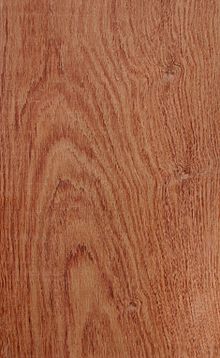Guibourtia coleosperma
| Guibourtia coleosperma | ||||||||||||
|---|---|---|---|---|---|---|---|---|---|---|---|---|
| Systematics | ||||||||||||
|
||||||||||||
| Scientific name | ||||||||||||
| Guibourtia coleosperma | ||||||||||||
| ( Benth. ) J. Leonard |
Guibourtia coleosperma is a tree in the legume family from the subfamily Caesalpinioideae from central to southern and southwestern Africa .
description
Guibourtia coleosperma grows as a mostly semi- evergreen tree with a wide crown up to 30 meters high. The trunk diameter reaches up to 55-65 centimeters. The trunk is slightly corrugated at the base or smaller buttress roots are formed. The relatively smooth bark is brownish to grayish and scaly.
The pinnate and alternate, stalked, bare leaves are twofold. The petiole is up to 4 inches long. The two almost sessile and egg-shaped to elliptical, entire-margined leaflets , with a sickle-shaped, uneven blade, are up to 12 centimeters long and up to 6 centimeters wide. The facing halves of the spreader are usually much smaller. At the tip, the leaflets are rounded to pointed or pointed, less often rounded. The smaller stipules fall off early.
Terminal or axillary and panicle , slightly hairy inflorescences are formed. The hermaphroditic and fragrant, small, stalked flowers with a simple flower envelope , the petals are missing, are whitish to cream-colored. The 4–5 inside hairy sepals are unequal and 5–6 millimeters long. There are 10 alternating stamens of unequal length . The unilocular, bare and short pedunculated ovary is constantly medium with a solid-inverted conical stylus and smaller, capitate scar .
Small, up to 3.5 centimeters in size, obliquely wide-elliptical and flattened, brown, bare, lonely, leathery, tipped legumes are formed. The only, somewhat flattened and up to 2 centimeters large, egg-shaped to elliptical, brown, slightly shiny seed is covered by a red aril . When the fruit opens, the seed hangs out on a long funiculus .
The number of chromosomes is 2n = 48.
use
The seeds are used cooked.
The fruits or the aril are edible. The aril is used cooked in a soup.
The bark is used medicinally.
The beautiful, heavy, hard and reddish wood is in great demand. It is known as African Rosewood , Mushibi , Rhodesian Copalwood, Teak or Mahagony, as well as Muzaule .
literature
- RHMJ Lemmens, D. Louppe, AA Oteng-Amoako: Plant Resources of Tropical Africa. 7 (2): Timbers 2 , PROTA, 2012, ISBN 978-92-9081-495-5 , pp. 370-373.
- The CABI Encyclopedia of Forest Trees. CABI, 2013, ISBN 978-1-78064-236-9 , p. 226 f.
Web links
- Guibourtia coleosperma at Useful Tropical Plants.
- Guibourtia coleosperma . In: S. Dressler, M. Schmidt, G. Zizka (Eds.): African plants - A Photo Guide. Senckenberg, Frankfurt / Main 2014.
- Guibourtia coleosperma at Photo Guide to Plants of Southern Africa (pictures).
